ASUS TUF FX705 review – AMD Ryzen 7 3750H knocks on the door of gaming laptops
 Not long ago we provided you with our thoughts on the ASUS TUF FX505 – part of a line-up which is a budget substitution for the ROG series. Today we are looking at the bigger brother of this device. It is called the TUF FX705 and is practically the third notebook of the TUF series.
Not long ago we provided you with our thoughts on the ASUS TUF FX505 – part of a line-up which is a budget substitution for the ROG series. Today we are looking at the bigger brother of this device. It is called the TUF FX705 and is practically the third notebook of the TUF series.
You can get it with either the Core i5-8300H or the more powerful core i7-8750H. On the GPU front, you have the whole mid-range spectrum to chose from – GTX 1050, 1050 Ti and 1060. However, behold the latest AMD Ryzen processor lineup. You can get either the Ryzen 5 3550H or the Ryzen 7 3750H, and pair it with a GTX 1650 or GTX 1660 Ti. It is interesting to see how a 17-inch all plastic budget-oriented gaming machine will fare against its competition. The main opponent is Dell G3 17 3779.
You can check the prices and configurations in our Specs System: https://laptopmedia.com/series/asus-tuf-gaming-fx705/
Contents
- Specs Sheet
- What’s in the box?
- Design and construction
- Disassembly, upgrade options and maintenance
- Display quality
- Health impact – PWM / Blue Light
- Buy our profiles
- Sound
- Drivers
- Battery
- CPU options
- GPU options
- Gaming tests – AMD Ryzen 7 3750H + GeForce GTX 1650
- Gaming tests – Intel Core i7-8750H + GeForce GTX 1050 Ti
- Temperatures and comfort – AMD Ryzen 7 3750H + GeForce GTX 1650
- Temperatures and comfort – Intel Core i7-8750H + GeForce GTX 1050 Ti
- Verdict
Specs Sheet
ASUS TUF Gaming FX705 technical specifications table
What’s in the box?
The box contains some manuals, the laptop itself and a DVD. This is a usual finding for a TUF device – DVD with all the drivers and utilities, without any possibility to read it on the notebook. Lastly, we have a pretty beefy 120W charging unit.
Design and construction
Probably because of its plastic body or the tiny bezels around the screen, the TUF FX705 is one (if not the) the lightest 17-inch gaming notebooks on the market. It weighs exactly 2.6 kg (5.7 lbs) and has a 26.6 mm profile. One can easily mistake it for the FX505 since it looks absolutely the same… well, until you put them side by side.
ASUS TUF FX705 / ASUS TUF FX505
As we mentioned above, the screen is surrounded by relatively narrow bezels – ASUS is keeping up with the trend very nicely here. Let us remind you that last year they converted their ROG line-up to bezel-less design as well, with the GL504.
Looking at the base of the device we see a similar picture. Full-blown keyboard experience with all of the keys on board – thankfully. Although the arrow keys are stuck to the rest of the keyboard, which makes them hard to distinguish when you’re not looking at them. We also feel that the keyboard could have been better. The keys feel a little soft, although they have good travel.
Then comes the touchpad which is the same problematic piece of … technology. If you have problems with yours, you can fix it by downloading and installing the BIOS update, followed by the Chipset driver and only then – the touchpad driver. It should work and you should have a good touchpad.
On the bottom, you can see some vents which are where the cold air enters the system. Still on the bottom plate, but on the sides of it, are located the 2W speakers, while the hot air exits the laptop from the back of the device.
| Width | Length | Height | Weight | |
|---|---|---|---|---|
| ASUS TUF FX705 | 400 mm (15.75″) | 279 mm (10.98″) | 26.6 mm (1.05″) | 2.60 kg (5.7 lbs) |
| Dell G3 17 3779 | 415 mm (16.34″) | 279 mm (10.98″) | 25 mm (0.98″) (-6%) | 3.27 kg (7.2 lbs) (+26%) |
Ports
Once again we see a port selection entirely placed on the left side of the FX705. This is very good if you are right-handed. However, if you are from the 5-30% of the people who happen to be left-handed, this is definitely not the laptop for you.
Apparently, on the left side of the laptop, you can see a charging plug, an RJ-45 and HDMI connectors, a USB Type-A 2.0 port, followed by two USB Type-A 3.1 (Gen. 1) ports and a combo Audio jack.
Disassembly, upgrade options and maintenance
Similarly to its smaller sibling, TUF FX705 is easy to disassemble. Despite the different length of the screws, it is hardly possible for you to mistake their places. After carefully unprying the bottom panel, we saw something quite weird. Basically, ASUS has put the TUF FX505 in a bigger chassis.
There are a total of two heat pipes – one solely used for the GPU and one cooling both of the chips. This may impede the thermal efficiency.
On the bright side, this notebook is easily upgradable, having an M.2 slot with NVMe support, one SATA slot, occupied by a FireCuda SSHD, as well as two RAM DIMMs.
Thankfully, ASUS has managed make some use of the larger space inside the machine – they’ve put a larger 64Wh battery pack.
Display quality
ASUS TUF FX705 is equipped with a Full HD IPS screen, model number AUO B173HAN04.2. Its diagonal is 17.3″ (43.94 cm), and the resolution – 1920 х 1080. Additionally, the screen ratio is 16:9, the pixel density – 127 ppi, their pitch – 0.1995 x 0.1995 mm. The screen can be considered Retina when viewed from at least 69 cm (from this distance, the average human eye can’t see the individual pixels).

The viewing angles are comfortable. We have provided images at 45 degrees to evaluate quality.

The maximum measured brightness is relatively high – 341 nits (cd/m2) in the middle of the screen and 327 nits (cd/m2) average across the surface with a maximum deviation of 10%. The Correlated Color Temperature on a white screen and at maximum brightness is 6900K (average) – colder than the 6500K optimum for sRGB. The average color temperature through the grey scale before profiling is 6740K.
In the illustration below you can see how the display performs from uniformity perspective. The illustration below shows how matters are for operational brightness levels (approximately 140 nits) – in this particular case at 40% Brightness (White level = 141 cd/m2, Black level = 0.13 cd/m2).
Values of dE2000 over 4.0 should not occur, and this parameter is one of the first you should check if you intend to use the laptop for color sensitive work (a maximum tolerance of 2.0 ). The contrast ratio is very good – 1080:1 (1060:1 after profiling).

To make sure we are on the same page, we would like to give you a little introduction to the sRGB color gamut and the Adobe RGB. To start, there’s the CIE 1976 Uniform Chromaticity Diagram that represents the visible specter of colors by the human eye, giving you a better perception of the color gamut coverage and the color accuracy.
Inside the black triangle, you will see the standard color gamut (sRGB) that is being used by millions of people in HDTV and on the web. As for the Adobe RGB, this is used in professional cameras, monitors etc for printing. Basically, colors inside the black triangle are used by everyone and this is the essential part of the color quality and color accuracy of a mainstream notebook.
Still, we’ve included other color spaces like the famous DCI-P3 standard used by movie studios, as well as the digital UHD Rec.2020 standard. Rec.2020, however, is still a thing of the future and it’s difficult for today’s displays to cover that well. We’ve also included the so-called Michael Pointer gamut, or Pointer’s gamut, which represents the colors that naturally occur around us every day.
The yellow dotted line shows ASUS TUF FX705’s color gamut coverage.
Its display covers 91% of the sRGB/ITU-R BT.709 (web/HDTV standard) in CIE1976.
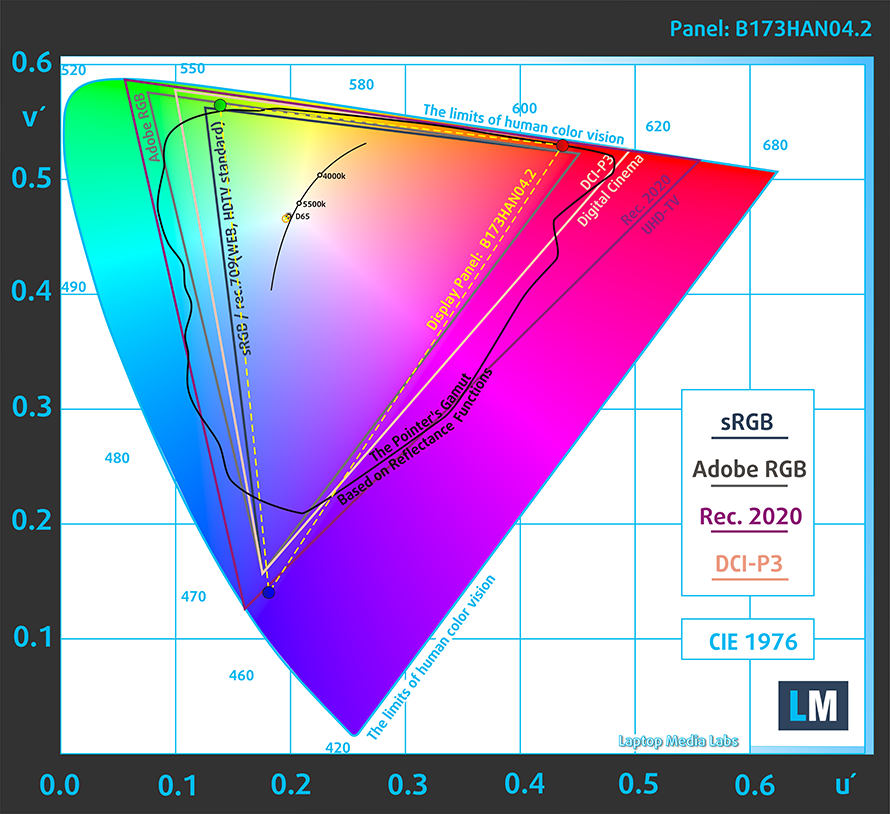
Our “Design and Gaming” profile delivers optimal color temperature (6500K) at 140 cd/m2 luminance and sRGB gamma mode.
We tested the accuracy of the display with 24 commonly used colors like light and dark human skin, blue sky, green grass, orange etc. You can check out the results at factory condition and also, with the “Design and Gaming” profile.
Below you can compare the scores of ASUS TUF FX705 with the default settings (left), and with the “Gaming and Web design” profile (right).
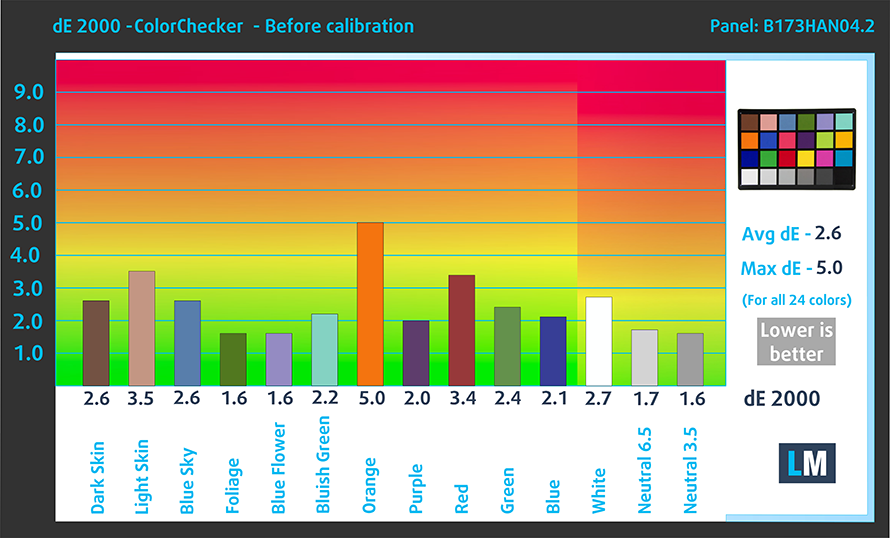
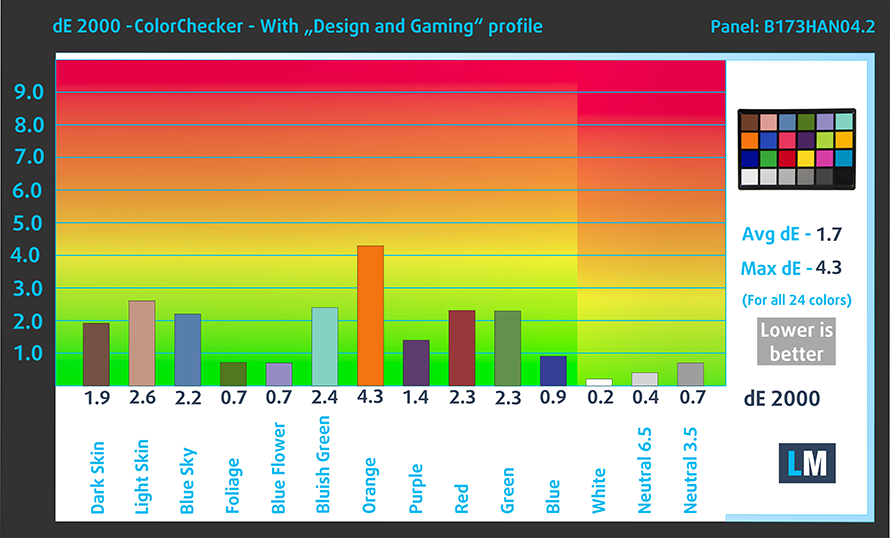
The next figure shows how well the display is able to reproduce really dark parts of an image, which is essential when watching movies or playing games in low ambient light.
The left side of the image represents the display with stock settings, while the right one is with the “Gaming and Web Design” profile activated. On the horizontal axis, you will find the grayscale and on the vertical axis – the luminance of the display. On the two graphs below you can easily check for yourself how your display handles the darkest nuances but keep in mind that this also depends on the settings of your current display, the calibration, the viewing angle, and the surrounding light conditions.
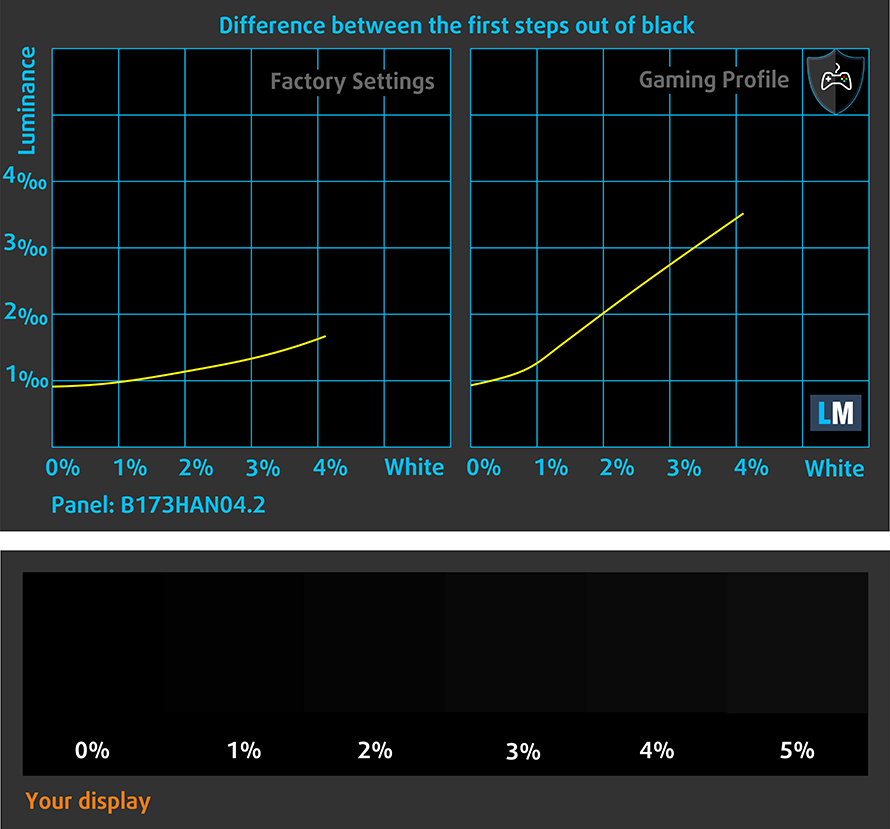
Response time (Gaming capabilities)
We test the reaction time of the pixels with the usual “black-to-white” and “white-to-black” method from 10% to 90% and vice versa.
We recorded Fall Time + Rise Time = 37 ms – the panel is pretty slow for a gaming device.
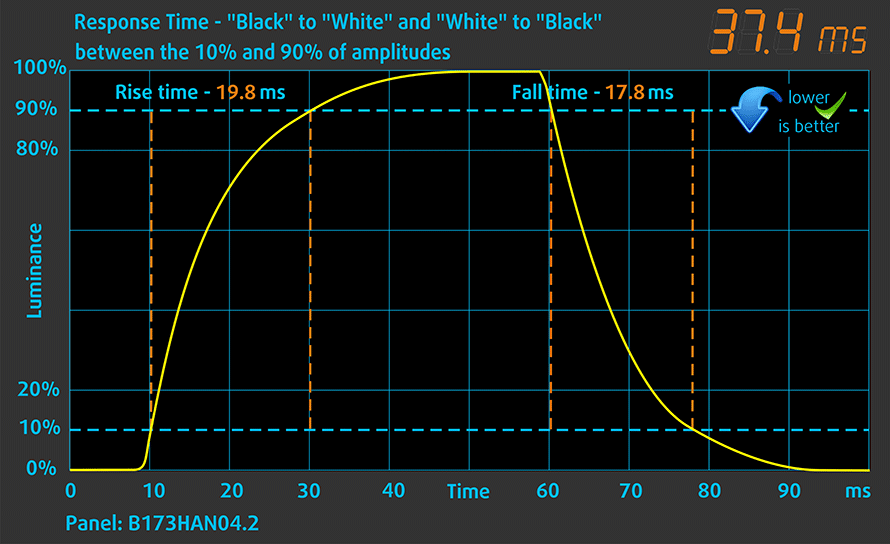
Health impact – PWM / Blue Light
PWM (Screen flickering)
Pulse-width modulation (PWM) is an easy way to control monitor brightness. When you lower the brightness, the light intensity of the backlight is not lowered, but instead turned off and on by the electronics with a frequency indistinguishable to the human eye. In these light impulses, the light/no-light time ratio varies, while brightness remains unchanged, which is harmful to your eyes. You can read more about that in our dedicated article on PWM.
ASUS has equipped the TUF FX705 with a screen which doesn’t use PWM to adjust its brightness. This ensures that the display is safe for use for long periods of time. Well… at least in this aspect.

Blue light emissions
Installing our Health-Guard profile not only eliminates PWM but also reduces the harmful Blue Light emissions while keeping the colors of the screen perceptually accurate. If you’re not familiar with the Blue light, the TL;DR version is – emissions that negatively affect your eyes, skin and your whole body. You can find more information about that in our dedicated article on Blue Light.
Conclusions
ASUS TUF FX705 is equipped with an all in all good quality IPS screen. It has comfortable viewing angles, 91% of sRGB coverage, and it doesn’t use PWM for brightness adjustment. In addition to that, it is very color accurate and with the help of our Gaming and Web design profile, the dE value goes under 2.0. This makes it suitable for designers, although, this is a gaming notebook, and the super slow response rate of the panel is not enhancing that feeling.
Buy our profiles
Since our profiles are tailored for each individual display model, this article and its respective profile package are meant for ASUS TUF FX705 configurations with 17.3″ AUO B173HAN04.2 (FHD, 1920 × 1080) IPS.
*Should you have problems with downloading the purchased file, try using a different browser to open the link you’ll receive via e-mail. If the download target is a .php file instead of an archive, change the file extension to .zip or contact us at [email protected].
Read more about the profiles HERE.
In addition to receiving efficient and health-friendly profiles, by buying LaptopMedia's products you also support the development of our labs, where we test devices in order to produce the most objective reviews possible.

Office Work
Office Work should be used mostly by users who spend most of the time looking at pieces of text, tables or just surfing. This profile aims to deliver better distinctness and clarity by keeping a flat gamma curve (2.20), native color temperature and perceptually accurate colors.

Design and Gaming
This profile is aimed at designers who work with colors professionally, and for games and movies as well. Design and Gaming takes display panels to their limits, making them as accurate as possible in the sRGB IEC61966-2-1 standard for Web and HDTV, at white point D65.

Health-Guard
Health-Guard eliminates the harmful Pulse-Width Modulation (PWM) and reduces the negative Blue Light which affects our eyes and body. Since it’s custom tailored for every panel, it manages to keep the colors perceptually accurate. Health-Guard simulates paper so the pressure on the eyes is greatly reduced.
Get all 3 profiles with 33% discount
Sound
ASUS TUF FX705 has relatively loud speakers. However, there are some deviations throughout the whole frequency range.
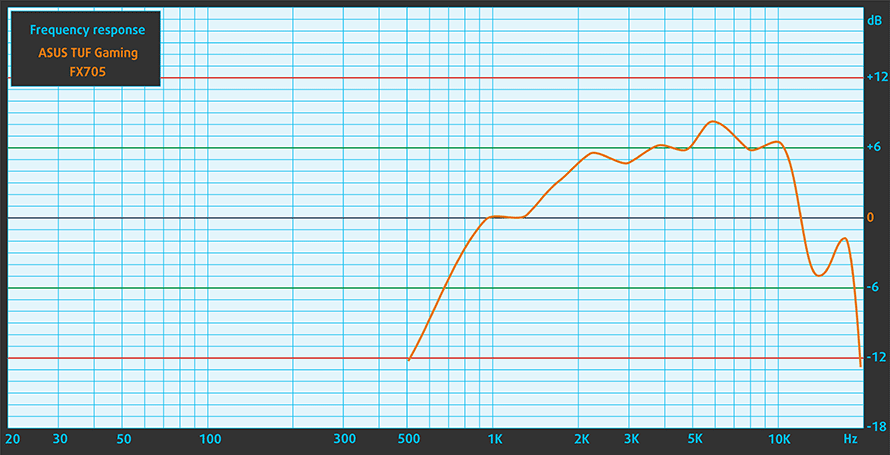
Drivers
You can find all the drivers and utilities for TUF FX705 on ASUS’s official webpage: https://www.asus.com/us/Laptops/ASUS-TUF-Gaming-FX705/HelpDesk_Download/
Keep in mind that there is a specific order when installing the drivers on a brand new Operating System. First comes the BIOS and Firmware, then Chipset, and only then you can successfully install the touchpad drivers.
Battery
Now, we conduct the battery tests with Windows Better performance setting turned on, screen brightness adjusted to 120 nits and all other programs turned off except for the one we are testing the notebook with. TUF FX705 is coming with a 64Wh battery unit – quite bigger than the 48Wh found in the FX505. However, keep in mind that the 17-inch screen needs more energy to be powered.
Despite the large display, we were able to extract 5 hours and 19 minutes of web browsing and around 5 hours of video playback from the battery. If you are crazy enough to play games away from the plug, you have exactly 100 minutes to do the job.
On the other side, you can see that AMD’s 12nm Zen architecture, paired with the Turing 12nm architecture of NVIDIA, results in a reasonably higher screen on times. The higher efficiency results in 6 hours and 40 minutes of web browsing and more than 7 hours of video playback.
In order to simulate real-life conditions, we used our own script for automatic web browsing through over 70 websites.


For every test like this, we use the same video in HD.


We use F1 2017’s built-in benchmark on loop in order to simulate real-life gaming.


CPU options
Currently, the TUF FX705 is available with a quad-core Intel Core i5-8300H or the more powerful hexa-core Core i7-8750H. If you are an AMD fan, there is the AMD Ryzen 5 3550H and the more powerful Ryzen 7 3750H.
Results are from the Cinebench 20 CPU test (the higher the score, the better)
Results are from our Photoshop benchmark test (the lower the score, the better)
GPU options
On the GPU side, you have a wider choice of products. The laptop can be bought with an NVIDIA GeForce GTX 1050, GTX 1050 Ti or GTX 1060. If you’d like a Turing GPU from NVIDIA, currently you have the GTX 1650 and GTX 1660 Ti, available. However, expect a higher price tag.
Results are from the 3DMark: Time Spy (Graphics) benchmark (higher the score, the better)
Results are from the 3DMark: Fire Strike (Graphics) benchmark (higher the score, the better)
Results are from the 3DMark: Wild Life benchmark (higher the score, the better)
Results are from the Unigine Superposition benchmark (higher the score, the better)
ASUS TUF Gaming FX705 GPU variants
Here you can see an approximate comparison between the GPUs that can be found in the ASUS TUF Gaming FX705 models on the market. This way you can decide for yourself which ASUS TUF Gaming FX705 model is the best bang for your buck.
Note: The chart shows the cheapest different GPU configurations so you should check what the other specifications of these laptops are by clicking on the laptop’s name / GPU.
Results are from the 3DMark: Time Spy (Graphics) benchmark (higher the score, the better)
Results are from the 3DMark: Fire Strike (Graphics) benchmark (higher the score, the better)
Results are from the Unigine Superposition benchmark (higher the score, the better)
Gaming tests – AMD Ryzen 7 3750H + GeForce GTX 1650
Our first encounter with the Ryzen 7 3750H didn’t go very well. Combined with the GTX 1650 it posted a below average framerates.

| Grand Theft Auto V (GTA 5) | Full HD, Normal (Check settings) | Full HD, High (Check settings) | Full HD, Very High (Check settings) |
|---|---|---|---|
| NVIDIA GeForce GTX 1650 | 106 fps | 76 fps | 42 fps |

| Far Cry 5 | Full HD, Normal (Check settings) | Full HD, High (Check settings) | Full HD, Ultra (Check settings) |
|---|---|---|---|
| NVIDIA GeForce GTX 1650 | 57 fps | 53 fps | 50 fps |

| Rise of the Tomb Raider (2016) | Full HD, Lowest (Check settings) | Full HD, Medium (Check settings) | Full HD, Very High (Check settings) |
|---|---|---|---|
| NVIDIA GeForce GTX 1650 | 92 fps | 73 fps | 37 fps |

| Shadow of the Tomb Raider (2018) | Full HD, Lowest (Check settings) | Full HD, Medium (Check settings) | Full HD, High (Check settings) |
|---|---|---|---|
| NVIDIA GeForce GTX 1650 | 62 fps | 48 fps | 45 fps |

| Tom Clancy’s Ghost Recon Wildlands | Full HD, Medium (Check settings) | Full HD, High (Check settings) | Full HD, Very High (Check settings) |
|---|---|---|---|
| NVIDIA GeForce GTX 1650 | 52 fps | 48 fps | 42 fps |
Gaming tests – Intel Core i7-8750H + GeForce GTX 1050 Ti
As you can see from our tables below, the TUF FX705 equipped with GTX 1050 Ti performs regularly on par with the FX505. However, weirdly enough, there are some major differences in favor of the 15-inch notebook.

| Grand Theft Auto V (GTA 5) | Full HD, Normal (Check settings) | Full HD, High (Check settings) | Full HD, Very High (Check settings) |
|---|---|---|---|
| ASUS TUF Gaming FX705 | 111 fps | 73 fps | 40 fps |
| ASUS TUF Gaming FX505 | 131 fps | 77 fps | 41 fps |

| Far Cry 5 | Full HD, Normal (Check settings) | Full HD, High (Check settings) | Full HD, Ultra (Check settings) |
|---|---|---|---|
| ASUS TUF Gaming FX705 | 50 fps | 45 fps | 42 fps |
| ASUS TUF Gaming FX505 | 49 fps | 46 fps | 42 fps |

| Rise of the Tomb Raider (2016) | Full HD, Lowest (Check settings) | Full HD, Medium (Check settings) | Full HD, Very High (Check settings) |
|---|---|---|---|
| ASUS TUF Gaming FX705 | 86 fps | 61 fps | 26 fps |
| ASUS TUF Gaming FX505 | 93 fps | 63 fps | 29 fps |

| TC Rainbow Six Siege | Full HD, Medium (Check settings) | Full HD, High (Check settings) | Full HD, Very High (Check settings) |
|---|---|---|---|
| ASUS TUF Gaming FX705 | 107 fps | 91 fps | 84 fps |
| ASUS TUF Gaming FX505 | 110 fps | 92 fps | 85 fps |

| Tom Clancy’s Ghost Recon Wildlands | Full HD, Medium (Check settings) | Full HD, High (Check settings) | Full HD, Very High (Check settings) |
|---|---|---|---|
| ASUS TUF Gaming FX705 | 44 fps | 40 fps | 35 fps |
| ASUS TUF Gaming FX505 | 44 fps | 41 fps | 36 fps |
Temperatures and comfort – AMD Ryzen 7 3750H + GeForce GTX 1650
Max CPU load
In this test we use 100% on the CPU cores, monitoring their frequencies and chip temperature. The first column shows a computer’s reaction to a short load (2-10 seconds), the second column simulates a serious task (between 15 and 30 seconds), and the third column is a good indicator of how good the laptop is for long loads such as video rendering.
Average core temperature (base frequency + X); CPU temp.
| AMD Ryzen 7 3750H (35W TDP) | 0:02 – 0:10 sec | 0:15 – 0:30 sec | 10:00 – 15:00 min |
|---|---|---|---|
| ASUS TUF FX705 | 3.72 GHz (B+62%) @ 74°C | 3.62 GHz (B+57%) @ 73°C | 3.43 GHz (B+49%) @ 70°C |
Even though it was not able to reach its maximum frequency, the machine’s capability to retain a high clock speed was clearly impressive. Not only it runs above 3.40 GHz for the entire test, but the temperature it finished the test at was very cool.
Real gameplay
| NVIDIA GeForce GTX 1650 | GPU frequency/ Core temp (after 2 min) | GPU frequency/ Core temp (after 30 min) |
|---|---|---|
| ASUS TUF FX705 | 1566 MHz @ 74°C | 1568 MHz @ 74°C |
| Acer Nitro 7 (AN715-51) | 1633 MHz @ 61°C | 1599 MHz @ 67°C |
As you can see from the table above, ASUS TUF FX705 fails to match the standards set by the Acer Nitro 7 (AN715-51). Well, frequency-wise it gets there – the difference is not big at all, however, as of the temperatures – in the beginning, there is a whopping 13C gap, that closes to a 7C one at the end of the test.
Gaming comfort
Our IR images show that the hottest spot is located between the “9” and “0” keys, and reaches the rather warm but comfortable 47C.
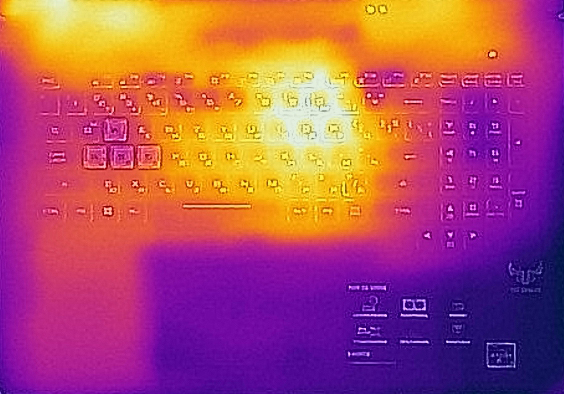
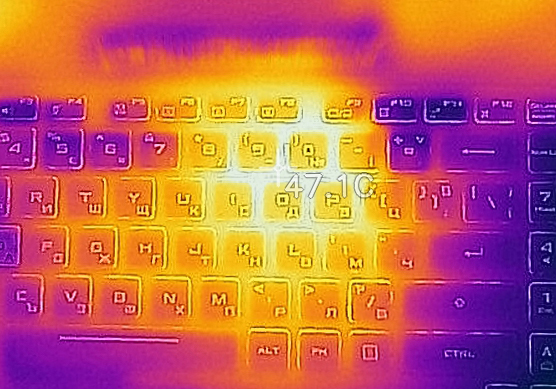
Temperatures and comfort – Intel Core i7-8750H + GeForce GTX 1050 Ti
Max CPU load
In this test we use 100% on the CPU cores, monitoring their frequencies and chip temperature. The first column shows a computer’s reaction to a short load (2-10 seconds), the second column simulates a serious task (between 15 and 30 seconds), and the third column is a good indicator of how good the laptop is for long loads such as video rendering.
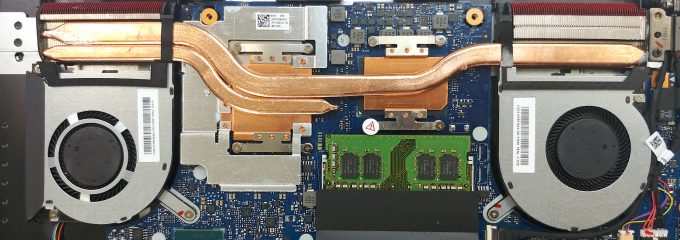
Average core temperature (base frequency + X); CPU temp.
| Intel Core i7-8750H (45W TDP) | 0:02 – 0:10 sec | 0:15 – 0:30 sec | 10:00 – 15:00 min |
|---|---|---|---|
| ASUS TUF FX705 | 3.57 GHz (B+62%) @ 88°C | 2.98 GHz (B+35%) @ 87°C | 2.75 GHz (B+25%) @ 80°C |
| Lenovo Legion Y730 | 3.48 GHz (B+56%) @ 91°C | 3.23 GHz (B+47%) @ 94°C | 2.69 GHz (B+22%) @ 79°C |
| Acer Nitro 5 | 2.89 GHz (B+31%) @ 72°C | 2.71 GHz (B+23%) @ 78°C | 2.52 GHz (B+15%) @ 74°C |
In the temperature test we saw some pretty strong results from the TUF FX705. However, keep in mind that there is a lot of space inside the body of this behemoth. Thus, we expected the Core i7-8750H to feel just right inside the notebook.
It started the test with 3.57 GHz at 88°C. Shortly after it dropped down to 2.98 GHz, cutting a degree of its temperature. At the final five minutes of the test, the TUF FX705 was able to provide better cooling for the Core i7-8750H than the Legion Y730. However, we have to note that we were barely able to hear our thoughts as the fans were blowing at maximum speed.
Real gameplay
| GPU frequency/ Core temp (after 2 min) | GPU frequency/ Core temp (after 30 min) | |
|---|---|---|
| ASUS TUF FX705 | 1683 MHz @ 85°C | 1670 MHz @ 87°C |
| ASUS TUF FX505 | 1696 MHz @ 79°C | 1683 MHz @ 84°C |
| Dell G3 17 3779 | 1683 MHz @ 77°C | 1670 MHz @ 88°C |
| Lenovo Legion Y730 [Sample] | 1734 MHz @ 66°C | 1721 MHz @ 71°C |
The controversies continued to the gaming temperature test. Even after 2 minutes of playing Rise of the Tomb Raider, the GeForce GTX 1050 Ti inside this laptop reached a ridiculous 85°C. This is one of the worst thermal efficiencies on a 17-incher. The clock speeds were a little lower than its smaller brother, while the temperatures were higher. Weird…
Gaming comfort
All in all, the picture here is not that bad – the palmrest area was relatively cool, as well as the “WASD” keys. However, moving to the center of the keyboard – in the bottom left to the “P” key things go red hot. For real, it feels like a portal to Oblivion is about to open there.

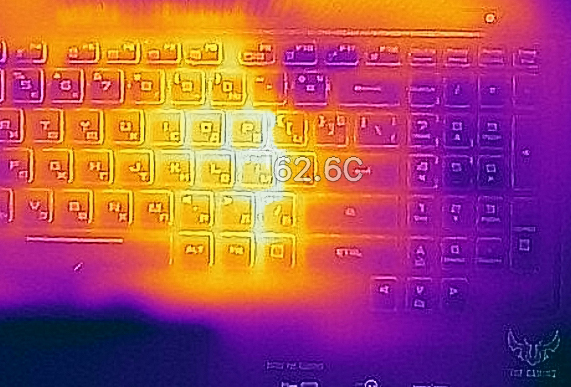
Verdict
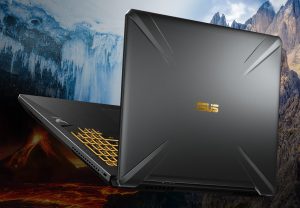 When it comes to choosing a 17-inch budget gaming laptop, the matter is very complicated. Currently, one of the best options on the market would be either the Dell G3 17 3779 or the ASUS TUF FX705. They have more things in common than differences actually. The major one is actually the look. While Dell’s G3 unit is more lowkey and doesn’t give itself up for being a gaming device, TUF FX705 screams gaming from miles away. However, it has a smaller footprint and is significantly lighter – it weighs 670 grams less, to be precise.
When it comes to choosing a 17-inch budget gaming laptop, the matter is very complicated. Currently, one of the best options on the market would be either the Dell G3 17 3779 or the ASUS TUF FX705. They have more things in common than differences actually. The major one is actually the look. While Dell’s G3 unit is more lowkey and doesn’t give itself up for being a gaming device, TUF FX705 screams gaming from miles away. However, it has a smaller footprint and is significantly lighter – it weighs 670 grams less, to be precise.
In addition to that, the TUF FX705 has a 64Wh battery – not that it’s a big one, especially given the amount space inside, but it lasts for five hours of web browsing. Keep in mind that it has a huge 17.3-inch screen to power, though.
Speaking of the screen, ASUS has made clear that they are not joking around with cheap-a** panels. The AUO B173HAN04.2 inside this machine has good maximum brightness and covers 91% of the colors found on the Web. In addition to that it is pretty color accurate, so web designers, this one would be a good hit. However, bearing in mind that this is mainly a gaming laptop, we have to note that the display works at only 60 Hz. Not only that but with 37 ms response rate it is pretty slow.
And then we come to the last issue of this device – its thermals. It is often that we see gaming notebooks with a couple of modes – the regular one, and performance mode, which boosts the fan speeds to the maximum speed in order to ensure no framerate loss during extended gaming sessions. Well… you simply don’t need it here, as they automatically reach a temperature which triggers them to work at 100% good 5 minutes into a game. This temperature, more specifically, is the scorching 87°C.
Of course, this is when you opt for the Pascal family of graphics cards and the not very efficient Core i7-8750H. However, if you choose the AMD version, believe it or not, the laptop becomes a lot cooler and reasonably quieter, while on the gaming side it becomes more capable. This is thanks to the Turing graphics cards (yet no RTX, sadly). Additionally, we noticed that the GTX 1650 was underperforming in gaming, especially when compared to the Acer Nitro 7 (AN715-51).
Enough about the ASUS TUF FX705, guys. This laptop has some pretty interesting competitors on the market and most of them had to cut something off in order to lower the price. Some of them are the ASUS ROG GL702VS, Acer Predator Helios 300, HP OMEN 17 and Acer Aspire 7 (A717-71G/72G). Also worth your attention are ASUS ROG GL703 and of course the Dell G3 17 3779
Pros
- IPS panel covers 91% of sRGB gamut (AUO B173HAN04.2)
- Lack of PWM (AUO B173HAN04.2)
- Adequate and easy for upgrade storage and memory
- A relatively low price tag
- AMD’s Ryzen CPU turned out to be very efficient
Cons
- Plastic build
- Not well utilized internal space
- Underperforming graphics card
- The 60Hz panel has even slower than usual response times (AUO B173HAN04.2)
You can check the prices and configurations in our Specs System: https://laptopmedia.com/series/asus-tuf-gaming-fx705/

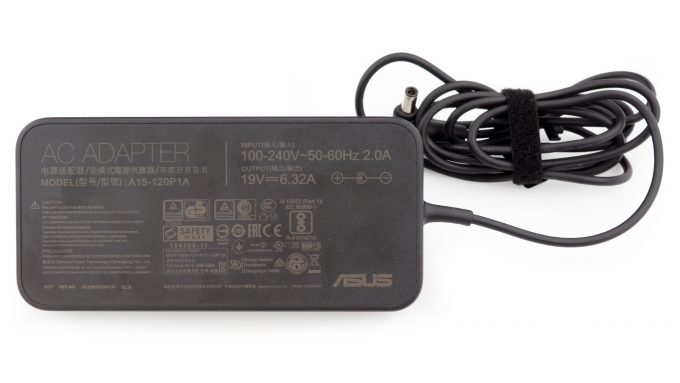
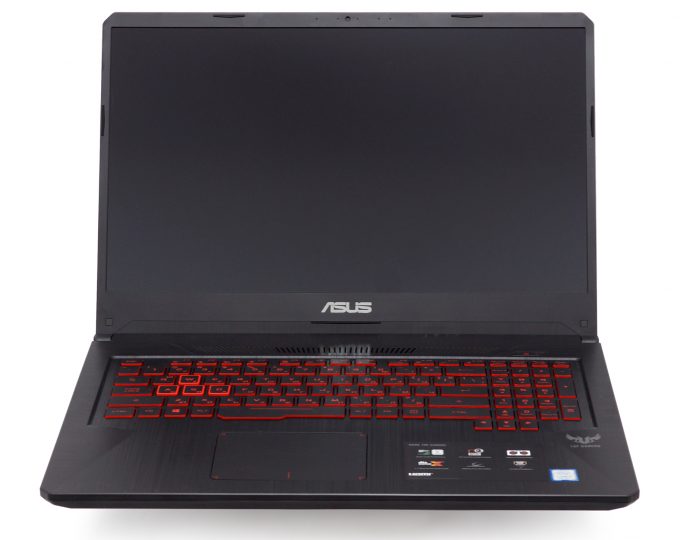


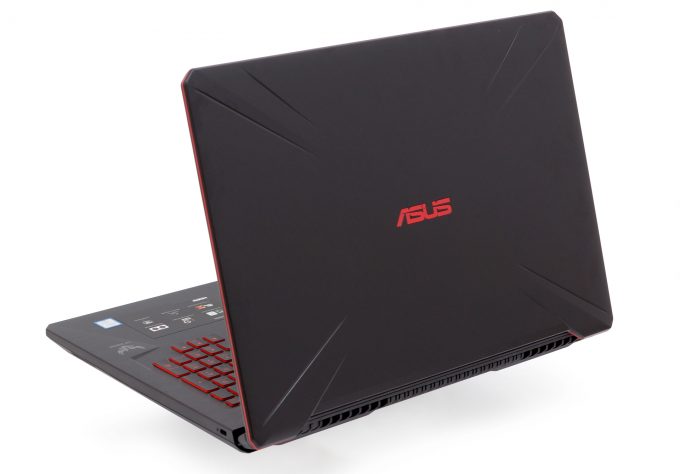
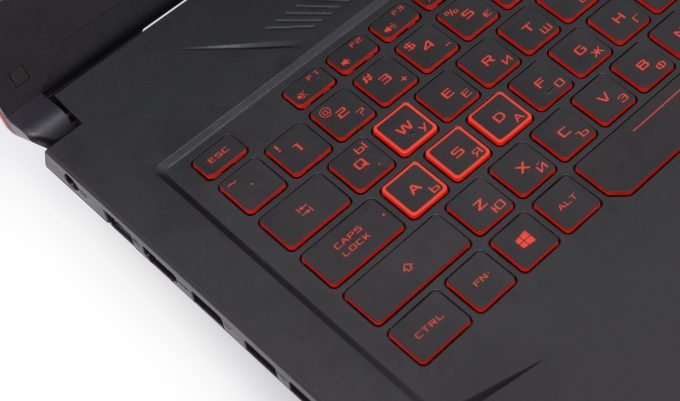

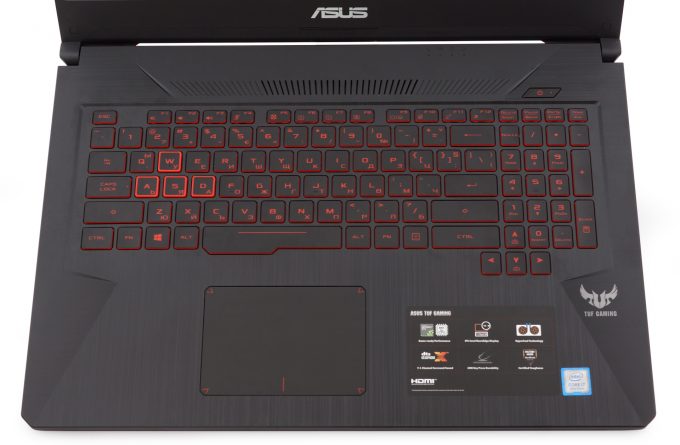


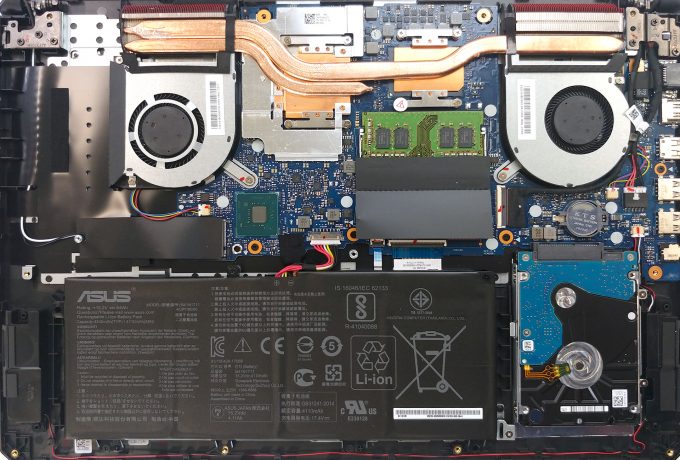
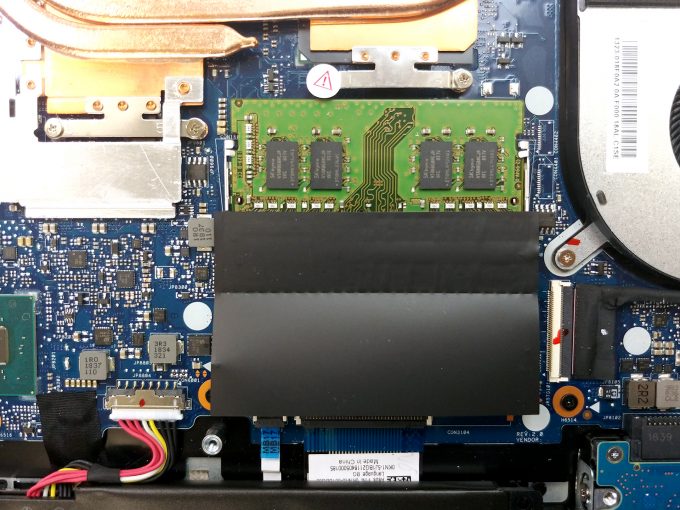
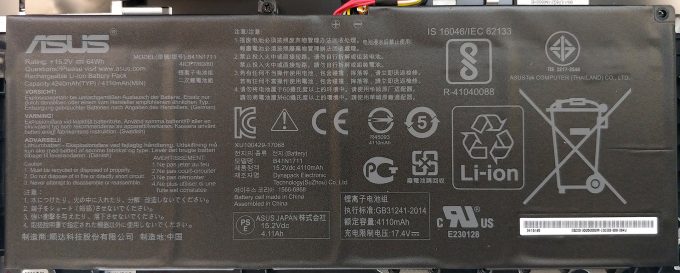

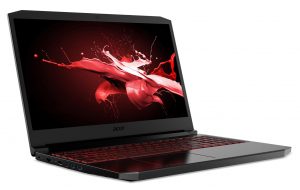
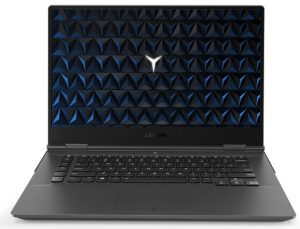








are those temps safe for the laptop … 90 degrees plus wont damage it ?